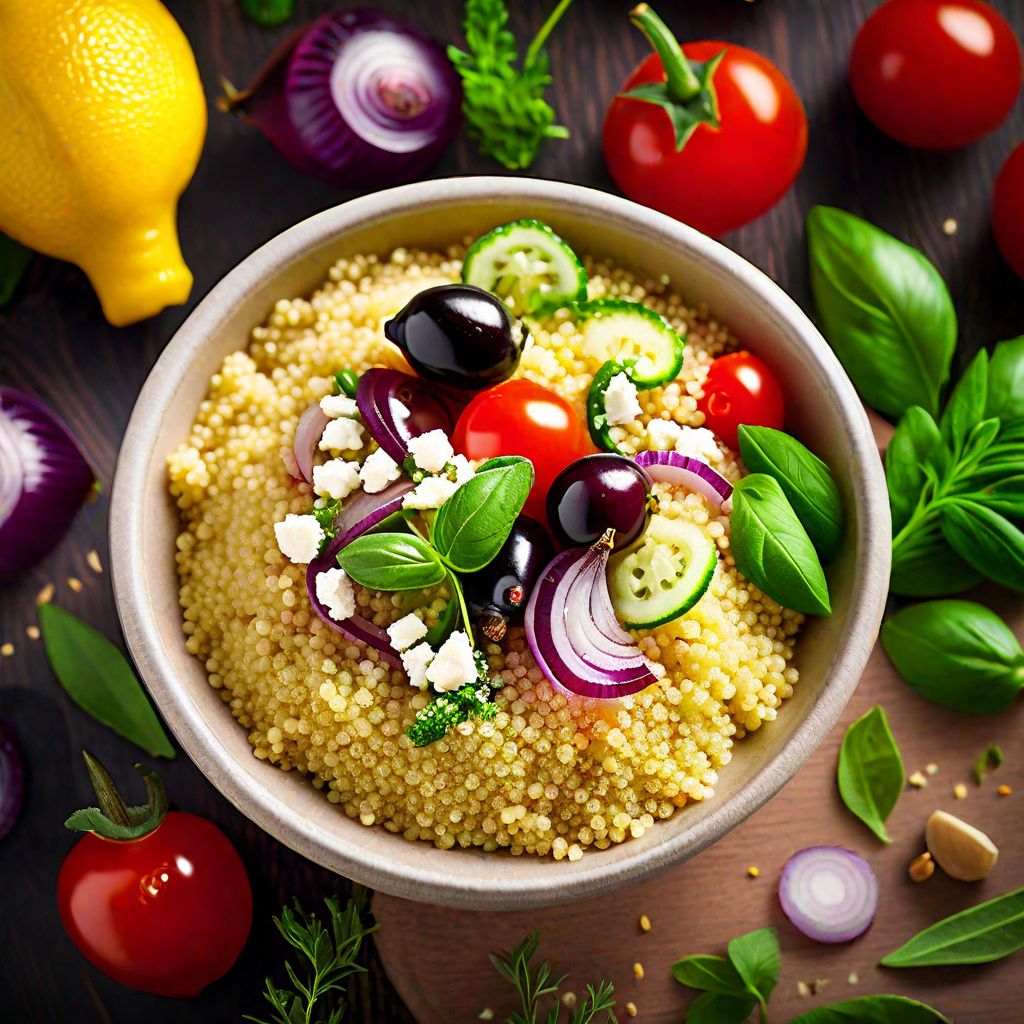
Recipe
Greek-style Couscous with Mediterranean Flavors
Mediterranean Delight: Greek-inspired Couscous with a Twist
4.9 out of 5
Transport your taste buds to the sunny shores of Greece with this delightful Greek-style couscous. Bursting with Mediterranean flavors, this dish combines the traditional North African staple with Greek ingredients and spices. The result is a harmonious blend of cultures that will leave you craving for more.
Metadata
Preparation time
15 minutes
Cooking time
10 minutes
Total time
25 minutes
Yields
4 servings
Preparation difficulty
Easy
Suitable for
Mediterranean diet, Vegetarian, Vegan (omit feta cheese), Gluten-free (use gluten-free couscous), Dairy-free (omit feta cheese)
Allergens
Wheat (if not using gluten-free couscous), Dairy (if not omitting feta cheese)
Not suitable for
Paleo, Keto, Low-carb, Nut-free, Soy-free
Ingredients
While the original North African couscous is typically prepared with spices like cumin and coriander, the Greek adaptation incorporates flavors such as lemon, oregano, and feta cheese. Additionally, Greek cuisine often includes ingredients like olives, tomatoes, and cucumbers, which add a refreshing twist to the dish. We alse have the original recipe for Couscous (dish), so you can check it out.
-
1 cup (200g) couscous 1 cup (200g) couscous
-
1 1/4 cups (300ml) vegetable broth 1 1/4 cups (300ml) vegetable broth
-
2 tablespoons olive oil 2 tablespoons olive oil
-
1 small red onion, finely chopped 1 small red onion, finely chopped
-
2 cloves garlic, minced 2 cloves garlic, minced
-
1 teaspoon dried oregano 1 teaspoon dried oregano
-
1/2 teaspoon lemon zest 1/2 teaspoon lemon zest
-
1/4 cup (60ml) lemon juice 1/4 cup (60ml) lemon juice
-
1 cup (150g) cherry tomatoes, halved 1 cup (150g) cherry tomatoes, halved
-
1/2 cup (75g) Kalamata olives, pitted and sliced 1/2 cup (75g) Kalamata olives, pitted and sliced
-
1/2 cup (75g) cucumber, diced 1/2 cup (75g) cucumber, diced
-
1/4 cup (30g) crumbled feta cheese 1/4 cup (30g) crumbled feta cheese
-
Salt and pepper to taste Salt and pepper to taste
-
Fresh parsley, for garnish Fresh parsley, for garnish
Nutrition
- Calories: 250 kcal / 1046 KJ
- Fat: 8g (Saturated Fat: 2g)
- Carbohydrates: 38g (Sugar: 4g)
- Protein: 6g
- Fiber: 4g
- Salt: 1g
Preparation
-
1.In a medium saucepan, bring the vegetable broth to a boil. Remove from heat and stir in the couscous. Cover and let it sit for 5 minutes until the couscous absorbs the liquid.
-
2.Fluff the couscous with a fork to separate the grains.
-
3.In a large skillet, heat the olive oil over medium heat. Add the red onion and garlic, and sauté until they become translucent.
-
4.Add the cooked couscous to the skillet and stir well to combine.
-
5.Sprinkle the dried oregano and lemon zest over the couscous. Pour in the lemon juice and mix thoroughly.
-
6.Add the cherry tomatoes, Kalamata olives, and cucumber to the skillet. Stir gently to incorporate the ingredients.
-
7.Cook for an additional 2-3 minutes until the tomatoes soften slightly.
-
8.Remove from heat and crumble the feta cheese over the couscous. Season with salt and pepper to taste.
-
9.Garnish with fresh parsley before serving.
Treat your ingredients with care...
- Couscous — Fluff the couscous with a fork after cooking to ensure light and fluffy grains.
- Lemon — Use organic lemons for the zest to avoid any bitterness from pesticides.
- Feta cheese — Opt for a high-quality feta cheese for the best flavor and texture.
- Kalamata olives — Rinse the olives before slicing to remove excess saltiness.
- Fresh parsley — Chop the parsley just before garnishing to retain its vibrant color and flavor.
Tips & Tricks
- For added flavor, toast the couscous in a dry skillet before cooking it in vegetable broth.
- Customize the dish by adding grilled chicken or shrimp for a protein boost.
- Experiment with different types of olives, such as green olives or a mix of varieties, to vary the flavor profile.
- Serve the couscous warm or chilled, depending on your preference.
- Leftovers can be stored in the refrigerator for up to 3 days and enjoyed as a refreshing cold salad.
Serving advice
Serve the Greek-style couscous as a main course or as a side dish alongside grilled fish or roasted vegetables. It pairs perfectly with a dollop of tzatziki sauce and a sprinkle of extra feta cheese for an extra burst of flavor.
Presentation advice
For an eye-catching presentation, mound the couscous in the center of a large serving platter and arrange fresh lemon wedges, cherry tomatoes, and Kalamata olives around it. Garnish with a sprig of fresh oregano or parsley for a pop of color.
More recipes...
For Couscous (dish) » Browse all
For North African cuisine » Browse all
More North African cuisine dishes

Couscous (dish)
Couscous
Couscous is a traditional North African dish made from small steamed balls of semolina. It is a staple food in many countries in the region and is...

Babor
Rice porridge
Babor is a traditional dish from Algeria that is made from semolina flour. It is a hearty and flavorful dish that is often served for breakfast or...
More Greek cuisine dishes » Browse all

Zoumero
Zoumero is a traditional Greek soup that is made with lentils and vegetables. It is a hearty and nutritious soup that is perfect for cold winter nights.

Soufiko
Vegetable Medley with Potatoes and Feta Cheese
Soufiko is a traditional Greek dish that is perfect for vegetarians and meat-eaters alike. It is a hearty and flavorful dish that is perfect for a...

Pain à la grecque
Pain a la grecque
Pain à la grecque is a traditional Greek bread that is sweet and delicious. It is perfect for breakfast or as a snack.








